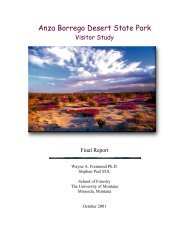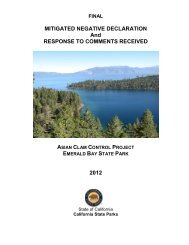Draft EIS/EIR for the San Luis Reservoir SRA Resource ...
Draft EIS/EIR for the San Luis Reservoir SRA Resource ...
Draft EIS/EIR for the San Luis Reservoir SRA Resource ...
Create successful ePaper yourself
Turn your PDF publications into a flip-book with our unique Google optimized e-Paper software.
5. Environmental Analysis<br />
greater than from <strong>the</strong> o<strong>the</strong>r alternatives. As described <strong>for</strong> Alternatives 2<br />
and 3, project-level documents will address potential site-specific wildlife<br />
impacts and location- and species-specific BMPs and measures such as<br />
those described in Section 5.4.3.4 to minimize and avoid those impacts.<br />
Minor residual impacts could remain.<br />
Camping, Boat Use, and Day Use All of <strong>the</strong> alternatives would continue<br />
recreational uses in <strong>the</strong> Plan Area. The action alternatives would allow <strong>for</strong> some<br />
expansion of facilities that would accommodate increased visitation and<br />
recreation uses. Increased recreation could have a range of direct and indirect<br />
effects to biological resources from <strong>the</strong> following mechanisms:<br />
• Reduction in habitat quality caused by human disturbance, including<br />
increased presence, noise, and light<br />
• Disturbance to vegetation that provides habitat <strong>for</strong> special-status species<br />
• Introduction of invasive species, including invasive mussels<br />
With all alternatives, visitor use of <strong>the</strong> Plan Area can be expected to increase as a<br />
result of population growth in Merced County and o<strong>the</strong>r nearby counties over <strong>the</strong><br />
Plan horizon (Section 2.12). In general, effects would be concentrated in <strong>the</strong><br />
vicinity of visitor-serving facilities. The degree of those effects would depend on<br />
<strong>the</strong> proximity of campsites, day use areas, interpretive facilities, and shoreline<br />
areas to sensitive biological resources.<br />
With all alternatives, <strong>the</strong> potential exists <strong>for</strong> wildlife to <strong>for</strong>age on human food at<br />
camping and picnic facilities as a result of improper storage or disposal. Human<br />
food may attract and support raccoons or striped skunks in mesic areas such as<br />
Basalt and Los Banos Creek use areas. These animals can carry rabies and pose<br />
an epidemiological threat to wildlife such as <strong>San</strong> Joaquin kit fox. Availability of<br />
human food may also alter <strong>the</strong> behavior of kit fox, which are adept at changing<br />
<strong>for</strong>aging patterns in urban areas to scavenge <strong>for</strong> food (USFWS 1998). Access to<br />
human food may also support feral cats, feral dogs, and red fox, a competitor of<br />
<strong>San</strong> Joaquin kit fox <strong>for</strong> food and dens.<br />
Noise and light associated with RV traffic, generators, and large groups of people<br />
(50 or more) in group picnic or camping facilities, especially during <strong>the</strong> dusk<br />
through dawn hours, have <strong>the</strong> potential to degrade habitat quality <strong>for</strong> animals such<br />
as <strong>San</strong> Joaquin kit fox and potentially nesting birds. Boating has <strong>the</strong> potential to<br />
introduce noise disturbance and human presence to shoreline areas and result in<br />
potential disturbance to waterfowl.<br />
Finally, with all alternatives, boating and o<strong>the</strong>r water-based recreation could result<br />
in <strong>the</strong> introduction of invasive quagga mussels (Dreissena rostri<strong>for</strong>mis bugensis)<br />
or zebra mussels (D. polymorpha) (Section 2.6.6.1). Invasive mussels can<br />
multiply quickly and clog waterways and infrastructure (e.g. pipelines), affect<br />
lake ecosystems, and create costly maintenance issues. The mussels consume<br />
large amounts of phytoplankton in water, which can lead to a reduction in<br />
zooplankton, some crustaceans, and fish (Cali<strong>for</strong>nia Science Advisory Panel<br />
<strong>San</strong> <strong>Luis</strong> <strong>Reservoir</strong> <strong>SRA</strong> 5-31<br />
<strong>Draft</strong> RMP/GP and <strong>Draft</strong> <strong>EIS</strong>/<strong>EIR</strong>
















